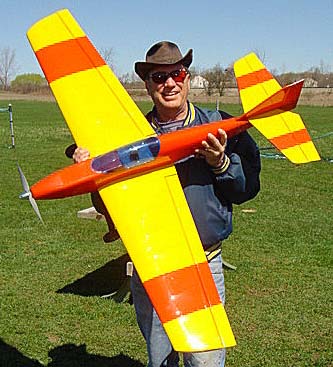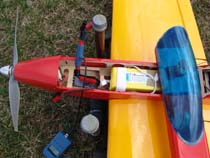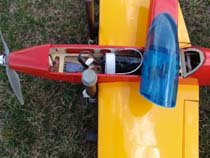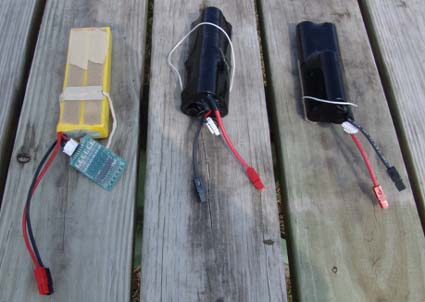Ken Myers Updated June, 2017 This article compares three different types of Lithium based batteries available in 2007. About halfway through the article, the effects of temperature on the performance of these lithium chemistry based cells are compared. For a direct comparison, the packs were used to replace the original 16-cell CBP Blaster 3300mAh NiMH pack in an ElectroFlying Fusion, low-wing, sport plane. The original NiMH power pack weighed a hefty 1015g/35.8 oz. 
Ken Myers with the Fusion in April of 2006 The article originally appeared in the May 2007 Ampeer as: of LiPo, M1/A123 & Emoli By Ken Myers The stand alone, online, version on this Web page article was previously updated in October of 2007. The Emoli cells, noted in this article, were used briefly by Milwaukee brand battery powered tools. They were available to the RC community and tested in various RC power applications, but they didn't work out well. References to them, on the Internet, disappeared around 2008. They are mentioned, and remain here, for historical purposes. In the summer of 2006, I was pulled kicking and screaming into the "LiPo" age. After physically damaging a 4S1P 4000mAh Skyshark RC pack in a crash due to a radio problem, I really felt that LiPo battery packs were a bit too fragile. I don't usually crash, but sometimes stuff just happens. All of the warnings and reports appearing about LiPo fires were also rather unnerving. (Remember this was 2006 & 2007.) I read as much as I could about the "lithium chemistry in a can" cells that were commonly called the M1/A123/DeWalt 36V cells and Emoli/E-moli/Milwaukee V28 cells. They were reported to better withstand a physical "oops" and not to be flammable during charge, physical damage and storage situations. I speculated, in the Ampeer, about them as well, based on published data. All of the published data, that I could find on the Internet or print magazines, was about one type or the other of these cell types, but there was never a direct comparison of the three cell types in the same application. I finally bit the bullet and purchased an Emoli pack and a M1/A123 (A123 2300mAh) pack to run a head-to-head comparison with one of the LiPo packs I used in 2006. For this comparison, I chose to use a 5S LiPo pack, 5S Emoli pack, and a 6S A123 2300mAh pack, as I expected them to be very similar in voltage. March 27, 2007 was supposed to be a prefect flying day. That morning I put Anderson Power Poles/APP (A.K.A. Sermos connectors) onto my new 6S A123 2300mAh pack and the 5S1P 3000mAh Emoli pack, both were from Big E RC, and charged them. I also charged my True RC 5S 4000mAh 10C LiPo pack. It had been in a "resting" state of charge (3.84v per cell) since last fall. My new "lithium in a can" packs were purchased from Mike at www.bigerc.com. They came fitted with the appropriate JST-XH balance connectors for my Astro Flight (AF) LiPo Blinky cell balancer. I had Mike use the optional 12-gauge wire for the battery cables when he custom made the packs. My ElectroFlying Models Fusion sport plane was chosen as the test bed. That model was chosen because it was/is such an excellent flier, whether powered by Ni-xx or Li-xx chemistry. The Plane stats: The ElectroFlying Fusion is a 4-function, low-wing sport plane with 569 sq.in. of wing area. It has a measured, ready to fly (RTF) weight of 58 oz./1644g without a battery. The motor is an AXI 4120/18 fed through a Hyperion 50-amp Opto electronic speed control (ESC) and spinning an APC 12x10E thin-electric prop. The Batteries: 
5S 4000mAh LiPo pack in Fusion 
6S A123 2300mAh in Fusion
The batteries' measured weights included the power cables, power connectors, balance connectors, Velcro and a pull string. Battery 1: Custom True RC 5S 4000mAh 10C LiPo. (home.comcast.net/~truerc/custompack.htm) The pack was rated at a continuous 10C (40 amps) discharge by the supplier. The dormant pack was charged at 1C (4 amps) using an Astro Flight 109 charger to bring the voltage up and then the pack was Blinky balanced.
Battery 2: The brand-new BigERC 5S1P 3000mAh Emoli pack was charged at 1C (3 amps) with the AF 109. (www.bigerc.com) The supplier rated the pack at a continuous 12C (36 amps) discharge. The individual cell voltages as received were, 3.90, 3.90, 3.90, 3.91, and 3.90. After the initial charge, the AF Blinky was used to balance the pack.
Battery 3: The brand-new BigERC 6S 2300mAh A123 pack showed all six of its cells reading 3.30 volts upon arrival. It was rated at a continuous 30C (69 amps) discharge by the supplier. It was charged at a 1C (2.3 amps) rate using the AF 109, which "saw" the pack as a 5S. After charging, the open voltages were all over the place. The cells were each charged separately to bring them all close to a resting voltage of 3.6v as measured with my voltmeter.
Today, June 2017, individual A123 2500mAh cells can be purchased for $9.30 each in quantities of 10 or greater from StorTronics in Livonia, MI. www.a123batteries.com/product-p/anr26650m1-b.htm Radical RC also sells the A123 1100mAh and 2500mAh cells. Even though the individual cells might be more expensive, the shipping is cheaper. It might be less expensive to order from Radical RC.
It was a sunny day at the Midwest RC Society 5 Mile Rd. flying field in Northville Twp., in southeastern MI. The air temperature was between 750F and 800F (23.90C - 26.70C) [very weird for March in Michigan!]. During the flight tests there was a 10 mph to 15 mph wind directly down the runway from the west. Before each flight, the Hyperion Emeter was used to take and record 5 full-throttle static readings. After logging the static readings, a timed 6-minute flight was made with each pack. There was no recharge after the data gathering. I tried to fly each flight in a similar fashion so that a direct comparison could be made. The static values given are the AVERAGE for the 5 static readings taken prior to each flight. These were the first flights of 2007 for me, so I was hoping not to "bump" a landing and break the prop, since I didn't have another APC 12x10E. The preflight True RC 5S1P LiPo cell resting voltages were measured at 4.08, 4.09, 4.09, 4.09 and 4.08. I noted from my battery log that this was lower than last fall.
Preflight resting voltages for the 5S1P BigERC Emoli were 4.13, 4.13, 4.13, 4.14 and 4.13 after being balanced with the AF Blinky.
The preflight cell resting voltages for the 6S1P BigERC M1/A123 were all approximately 3.6V. Really, they were "all over the place" with some being higher and some being lower.
The flight-testing proved to be exactly what the static testing had indicated. The LiPo was just ever so slightly better than the M1/A123 pack and the Emoli was noticeably a little less powerful in the air. The differences could be perceived in the horizontal "top end speed" and in the verticals and loops. Vertical climbs were pretty much identical with the LiPo and M1/A123 packs and not quite as "high" with the Emoli, but still good. Actually, all of the flights had excellent power for this plane. It was a cool 50-degreeish F (100C), non-flying day, with the winds 15 mph to 25 mph on March 28, 2007. I decided to repeat the static testing with the recharged packs. I did the testing in my dining room where there was plenty of ambient light available for the optical tach of the Emeter, and the ambient temperature was about 670F or 19.40C. The Fusion fuselage was restrained in a cradle. EFO V.P. Richard Utkan assisted by holding the fuselage in place while I took the Emeter readings. After taking individual cell readings of the Emoli pack of 4.14, 4.14, 4.15, 4.14, 4.14, it was placed in the plane and the Emeter hooked up. When we recorded the results we were a bit surprised. The averages for the five captures were down slightly from those I had taken at the field the previous day; 16.8V (down 0.43V from the day before), 28.4 amps (about the same), 477 watts in (down 11 watts) and an RPM of 7476 (down 162 RPM). Since this was the second use of this pack, we were expecting the numbers to be "up". Elevation: There is only a slight difference in elevation between my house and the flying field's elevation. Air Pressure: I didn't check either day but it might have been slightly higher on the 28th, as a storm erupted at the end of flying on the 27th indicating low pressure. Temperature: The temperature in my basement was measured at 630F (17.20C). That is where the pack was charged and kept until the test. The temperature in the dining room was ~670F (19.40C).
Warming certainly appeared to help the output of this pack! With that in mind, we heated the LiPo and M1/A123 packs for 5 to 6 minutes in the rice bag before testing. The LiPo pack resting voltages, after being Blinky balanced and before the data collection, were 4.15, 4.16, 4.15, 4.16, and 4.14. The average data recorded for the 5 runs was; 18.55V, 33.2 amps, 616 watts in, and 8078 RPM. Again, these numbers were slightly higher than collected at the field the previous day. The M1/A123 pack was the most interesting. Since I did not have a Blinky balancer for A123 cells (at that time), the pack was not balanced and the resting voltages were; 3.49, 3.49, 3.43, 3.46, 3.50, 3.48. The data was gathered and yielded; 18.0V, 31.4 amps, 566 watts in and 7,902 RPM. Again, this data was better than the data gathered at the field on the previous day.
I checked the Emoli pack and found it too had balanced itself to a perfect 4.05V per cell for all five cells. On the other hand, the LiPo pack exactly maintained its slight imbalance after the testing with a 0.04V drop in each cell after the test was run. Therefore the high cells in the pack that had read 4.16 before the test now read 4.12 after the test and the low cell at 4.14 was at 4.10 after the test. Every single cell showed exactly the same 0.04V drop. The LiPo seemed to be maintaining its slight imbalance. I was curious to see how much the rice bag may have warmed the packs. I have no way to measure the internal temperature of the packs, but I have an infrared thermometer that can read the external temperatures. It really isn't the best tool to use for this test as it changes temperature as it is pointed at different colors in the same ambient air. The black shrink on the M1/A123 pack sitting on my workbench in the basement read 62.30F (16.80C) while a white piece of paper, in the same ambient air, read 61.30F (16.30C). I heated the rice bag and then folded the 62.30F pack into it on the kitchen counter and set the timer for 6 minutes. A kitchen meat thermometer was also folded into the rice bag, but not touching the pack. At the end of the six minutes the meat thermometer read 1500F (65.60C) and the IR thermometer showed 85.40F (29.70C) on the black shrink of the pack when it was removed from the fold of the rice bag and placed on the counter. I returned to the field on March 30 for three more flight tests. I had charged the batteries at home and then placed them in heated rice bags inside my ammo can to take to the field. The air temperature was 630F (17.20C) when I arrived at the field and 650F (18.30C) when I finished the three flights with the Fusion. It was sunny and there was a 10 mph to 15 mph wind out of the east. I used the same procedure as the original flights, except the flight time was extended to 7 minutes. The Emoli pack was flown first. The cells' resting voltages after using the AF Blinky were; 4.14, 4.14, 4.14, 4.15, and 4.135. The averages gathered using the Emeter were; 17.56V, 31.08 amps, 547 watts in, and 7,716 RPM. The resting voltages the following morning were all 3.84v per cell. On the morning of the 31st, 2,154mAh were returned to the pack in 34 min. 15 sec. I wanted to charge at 3C, but the AF 109 topped out at 7.45 amps or about 2.5C. The Blinky was "happy" with the pack balance and the individual cell voltages read; 4.14, 4.14, 4.14, 4.15, 4.14. The M1/A123 pack was flown next. The cells' resting voltages at the field, after a forced overcharging of each cell at home on the AF 109, were; 3.74, 3.76, 3.76, 3.63, 3.66, and 3.75. The averages gathered using the Emeter were; 18.07V, 32.62 amps, 590 watts in, and 7878 RPM. Again, the resting voltages the following morning were very interesting, especially when the starting voltages were once again "all over the place." The resting voltages on the 31st were; 3.24, 3.25, 3.24, 3.245, 3.25, and 3.25. The AF 109 put 1,907mAh back into the pack raising the cell voltages to 3.39, 3.40, 3.39, 3.39, 3.39, and 3.39. Each cell was then charge at 1C using the AF 109 until it faulted in phase 3 of the charger. On average, the charger then added 127mAh to each cell bringing the total to 2,034mAh or about the same as the other two chemistries. Finally the True RC 4000mAh 10C LiPo was flown. The cells' resting voltages after using the AF Blinky were; 4.16, 4.17, 4.16, 4.17, and 4.16. The averages gathered using the Emeter were; 18.64V, 34.76 amps, 648 watts in, and 8,052 RPM. The resting voltages the following morning were all 3.82v per cell. On the morning of the 31st 2,096mAh was returned to the pack in 49 min. 51 sec. The resting voltages several hours after the charge were 4.16, 4.16, 4.16, 4.17, and 4.15. The AF Blinky started balancing and stopped when the individual cell voltages were at 4.13, 4.13, 4.13, 4.13 and 4.12. Below is a comparison table - reconfigured in June 2017  Looking at the chart, it seems that the Emoli cells, with less overall performance are clearly not the way to go. Unfortunately, life is not that simple. As previously mentioned, I originally had this plane set up with 16 CBP 3300mAh NiMH cells. At that time, the plane's ready to fly (RTF) weight was 93.4 oz. (2,659g), as the battery pack weighed 35.8 oz. (1015g). That gave the plane a wing cube loading (WCL) of 11.89. (That is a WCL level 5 plane, typical for advanced sport planes.) Checking my motor data for this motor and prop combination, I found that for three motor tests, using the same procedure outlined here, the average numbers were 17.33V, 29.3 amps, 508 watts in and 7700 RPM. That meant that the original watts in per pound was 87. The plane flew well, and I was pleased with its performance. If I had then switched to the Emoli pack, and knew that preheating helped so much, using the Day 2 data would have given me a WCL of 9.79 and watts in of 113.8 per pound. I would have been thrilled with the performance in both the power increase and weight reduction. The cost of the Emoli pack was only about $15 more than the 16-cell 3300mAh pack I made, so it would have been worth it, and I already had an AF 109 just sitting around waiting to be used. I actually bought the True RC 5S 4000mAh pack next and I was wowed. Even without preheating the pack it changed the WCL to 9.51 and watts in per pound to 124. Ever since then I have been touting this pack as the one to use in this combination. Fortunately, I have so far managed not to physically damage this pack through an oops at the field or charging mishap, but storing it and the other 4 LiPo packs I have, still continues to make me apprehensive. At first I was concerned that the A123 cells would not have a "good enough" capacity for the way I like to fly. I didn't realize that I was only using about 2000mAh doing a 7 minute flight, the way I fly. Now I realize that these cells do have the capacity to do exactly what I want to do. Using A123 2300mAh cells in the Fusion yields almost the same WCL, 9.55, as the LiPo pack and still, when preheated, a very respectable 125.9 watts in per pound. "I am going to start using the A123 2300mAh cells in all of my new sport and sport scale plane setups." At least that is what I said in an earlier draft of this article, but there was a new fly in the ointment! "Here is what I originally said when I thought for SURE that the A123 2300mAh cells were absolutely the way to go, "They provide the energy and duration I most often use at a very reasonable weight. They are the most expensive and will require a new or updated charger, but they offer a peace of mind that is an intangible benefit. I know that I can scavenge the cells out DEWALT 36V packs and lower the cost per cell, and I am capable of making up the packs myself. From my brief exposure to these cells, and the anecdotal evidence I've read in the magazines and on the Internet, they do not seem to need balancing taps, which simplifies pack construction, and they appear to be self-balancing. I can also charge them quickly and in the plane."
"I will continue to fly my True RC and Skyshark RC LiPo packs until they are "worn out", but I will continue to be extremely cautious when storing and charging them.
"I will most likely replace my "physically injured" Skyshark 4S1P 4000mAh LiPo with a 4S1P Emoli pack. That would allow me to not change the motor prop combination on the two planes I use that pack in. A 4S1P M1/A123 pack wouldn't provide enough power and a 5S1P M1/A123 would be too much for my intended use.
"I will not be purchasing any more Lithium Polymer packs for the majority of my projects.
Note: I never purchased any more Emoli cells, as I found A123 cells to be superior. When purchased in a DEWALT 36V power tool pack on ebay, they are the cheapest and best lithium type of cells to use in sport and sport scale applications. Oct. 2007 KM
A123 Systems Inc. made Horizon Hobby the only distributor for the A123 2300mAh cell to the hobby sector in the US. Horizon Hobby charged $19.95 per cell for single M1 cells. That meant that the only reasonable way to purchase A123 2300mAh cells was to purchase DEWALT 36V packs and scavenge the cells from them. A search of Ebay, at that time, showed DEWALT packs for about $120 including shipping. The DEWALT pack contains 10 cells. The really disturbing thing about all of this was what D.B. Mathews stated in his "Flying for Fun" column in the April 2007 issue of Model Aviation, p. 82, about these cells "The cells' distributor currently charges the toolmakers approximately $4 per cell..."
True RC 5S1P 4000mAh pack:
M1/A123/DeWalt 36V 6S1P 2300mAh pack:
Emoli/Milwaukee V28
After flying my A123 Systems 2300mAh packs all spring, summer and fall of 2007, I have realized that these are the best cells for me, my type of planes and flying style.
The power system has been changed. The Hyperion 50A Opto was recently changed to a Castle Creations' Phoenix Edge 50A with switching BEC. That means that the timing is most likely different from the Hyperion, as the timing in the CC Edge 50 is set to outrunner, while the Hyperion was set to low timing. The prop has, most likely, been changed since the original prop used for the 2007 testing, but it is still labeled APC 12x10E. There is no way to tell what iteration/version this one is, as APC has changed its props over the years. The charger is now a Revolectrix Gt500 and the measuring instrument is the Hyperion Emeter II instead of the Emeter with its optical tachometer. The motor is still the original AXI and the battery pack is the original Big E RC 6S 2300mAh A123 pack. The battery was charged to 3.7V per cell and allowed to sit for 1.5 hours at 230C. Fluke voltages before Emeter II test: pack 22.08V, #1 3.681V, #2 3.684V, #3 3.672V, #4 3.673V, #5 3.678V, #6 3.686V Average of 5 data captures from full pack at highest amp draw
Even using different measuring tools, and a different ESC and prop, it can be seen that the power system is still delivering at about the same level. To Reach Ken Myers, you can land mail to the address at the top of the page. My E-mail
address is:
KMyersEFO@mac.com
|
